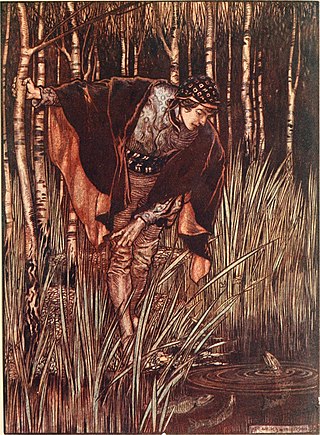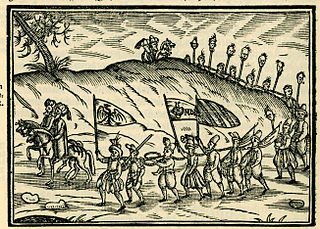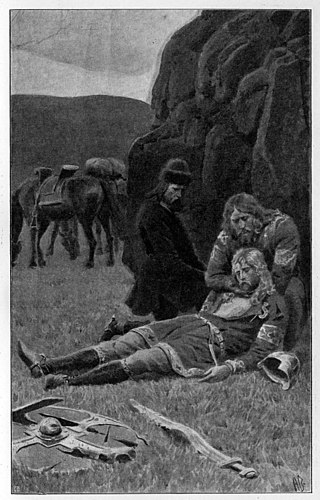
Concubinage is an interpersonal and sexual relationship between a man and a woman in which the couple does not want, or cannot enter into a full marriage. Concubinage and marriage are often regarded as similar but mutually exclusive.

Saint Brigid of Kildare or Saint Brigid of Ireland is the patroness saint of Ireland, and one of its three national saints along with Patrick and Columba. According to medieval Irish hagiographies, she was an abbess who founded the important abbey of Kildare, as well as several other convents of nuns. There are few historical facts about her, and her hagiographies are mainly anecdotes and miracle tales, some of which are rooted in pagan folklore. They say Brigid was the daughter of a chieftain and a slave woman, and was raised in a druid's household before becoming a consecrated virgin. She is patroness of many things, including poetry, learning, healing, protection, blacksmithing, livestock and dairy production. In her honour, a perpetual fire was kept burning at Kildare for centuries.
"Hush" is the tenth episode in the fourth season of the supernatural drama television series Buffy the Vampire Slayer (1997–2003). It was written and directed by series creator Joss Whedon and originally aired in the United States on December 14, 1999, on The WB. After reading critical response to the series in which the dialogue was praised as the most successful aspect of the show, Whedon set out to write an episode almost completely devoid of speech. Only about 17 minutes of dialogue is presented in the entire 44 minutes of "Hush".
Donna Jo Napoli is an American writer of children's and young adult fiction, as well as a linguist. She currently is a professor at Swarthmore College teaching Linguistics in all different forms .She has also taught linguistics at Smith College, the University of North Carolina at Chapel Hill, Georgetown University, the University of Michigan at Ann Arbor, the University of Pennsylvania,

Harem refers to domestic spaces that are reserved for the women of the house in a Muslim family. A harem may house a man's wife or wives, their pre-pubescent male children, unmarried daughters, female domestic servants, and other unmarried female relatives. In harems of the past, slave concubines were also housed in the harem. In former times some harems were guarded by eunuchs who were allowed inside. The structure of the harem and the extent of monogamy or polygamy has varied depending on the family's personalities, socio-economic status, and local customs. Similar institutions have been common in other Mediterranean and Middle Eastern civilizations, especially among royal and upper-class families, and the term is sometimes used in other contexts. In traditional Persian residential architecture the women's quarters were known as andaruni, and in the Indian subcontinent as zenana.

"The White Snake" is a German fairy tale collected by the Brothers Grimm and published in Grimm's Fairy Tales. It is of Aarne–Thompson type 673, and includes an episode of type 554.

The Black Bull of Norroway is a fairy tale from Scotland. A similar story titled The Red Bull of Norroway first appeared in print in Popular Rhymes of Scotland by Robert Chambers in 1842. A version titled The Black Bull of Norroway in the 1870 edition of Popular Rhymes of Scotland was reprinted in an Anglicised version by Joseph Jacobs in his 1894 book More English Fairy Tales.
Jan Janszoon van Haarlem, commonly known as Reis Mourad the Younger, was a former Dutch pirate who became a Barbary corsair in Ottoman Algeria and the Republic of Salé. After being captured by Algerian corsairs off Lanzarote in 1618, he converted to Islam and changed his name to Mourad. He became one of the most famous of the 17th-century Barbary corsairs. Together with other corsairs, he helped establish the independent Republic of Salé at the city of that name, serving as the first President and Commander. He also served as Governor of Oualidia.

Slavery in the Ottoman Empire was a lawful institution and a significant part of the Ottoman Empire's economy and traditional society. The main sources of slaves were wars and politically organized enslavement expeditions in the Caucasus, Eastern Europe, Southern Europe, the Balkans, and Africa. It has been reported that the selling price of slaves decreased after large military operations. In Constantinople, the administrative and political center of the Ottoman Empire, about a fifth of the 16th- and 17th-century population consisted of slaves. Statistics of these centuries suggest that Istanbul's additional slave imports from the Black Sea have totaled around 2.5 million from 1453 to 1700.

The Bible contains many references to slavery, which was a common practice in antiquity. Biblical texts outline sources and the legal status of slaves, economic roles of slavery, types of slavery, and debt slavery, which thoroughly explain the institution of slavery in Israel in antiquity. The Bible stipulates the treatment of slaves, especially in the Old Testament. There are also references to slavery in the New Testament.

Olaf the Peacock or Olaf Hoskuldsson was a merchant and chieftain of the early Icelandic Commonwealth, who was nicknamed "the Peacock" because of his proud bearing and magnificent wardrobe. He is a major character in the Laxdæla saga and is mentioned in a number of other Icelandic sources. The son of a slave woman, Olaf became one of the wealthiest landowners in Iceland and played a major role in its politics and society during the latter half of the tenth century. In addition to the Laxdæla Saga in which he takes a leading role, Olaf also is mentioned in Egils saga, Njáls saga, Gunnlaugs saga, Kormáks saga, Grettirs saga and the Landnámabók, among others.
Melkorka is the name given in Landnámabók and Laxdæla saga for the Irish mother of the Icelandic goði Ólafr Höskuldsson. It is possible that her name represents the Early Irish Mael Curcaig.

Hush, Hush is a 2009 New York Times bestselling young adult fantasy novel by Becca Fitzpatrick and the first book in her Hush, Hush series. The novel received rave reviews and focuses on Nora Grey, a teenager whose life is at risk after beginning a romance with new student Patch, a fallen angel with a dark connection to Nora.

Laxdæla saga, also Laxdœla saga, Laxdoela saga, Laxdaela saga or The Saga of the People of Laxárdalr, is one of the Icelanders' sagas. Written in the 13th century, it tells of people in the Breiðafjörður area of Iceland from the late 9th century to the early 11th century. The saga particularly focuses on a love triangle between Guðrún Ósvífrsdóttir, Kjartan Ólafsson and Bolli Þorleiksson. Kjartan and Bolli grow up together as close friends but the love they both have for Guðrún causes enmity between them.
Ulayya bint al-Mahdi was an Abbasid princess, noted for her legacy as a poet and musician.
Jórunn Bjarnadóttir is a female character who appears in Laxdœla saga, one of the Icelandic family sagas. She first appears in chapter 9, where she is introduced as the wife of a powerful Icelandic chieftain Höskuldr Dala-Kollsson from Höskuldsstaðir in Laxárdalur, Iceland.

The history of concubinage in the Muslim world encompassed the practice of a men living with a woman without marriage, where the woman was a slave, though sometimes free. If the concubine gave birth to a child, she attained a higher status known as Umm walad.

Concubinage in China traditionally resembled marriage in that concubines were recognized sexual partners of a man and were expected to bear children for him. Unofficial concubines were of lower status, and their children were considered illegitimate. The English term concubine is also used for what the Chinese refer to as pínfēi, or "consorts of emperors", an official position often carrying a very high rank. The practice of concubinage in China was outlawed when the Chinese Communist Party came to power in 1949.












